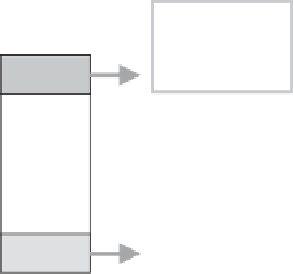Environmental Engineering Reference
In-Depth Information
Planktonic:
Stephanodiscus
Epiphytic:
Cocconeis
Higher plants:
Potamogeton
Callitriche
Nymphoea
Zooplankton:
Ceriodaphnia
Bosmina
Daphnia
TOP
Dominant
diatoms
Macroalgae and
higher plants
Invertebrates
Benthic:
Fragilaria
spp.
Characeae:
Nitella
,
Chara
Higher plants:
Myriophyllum,
Utricularia
Plant-associated:
Chydorid
BOTTOM
Figure 3.4
Multi-proxy palaeoecological analysis of a sediment core: Groby Pool, United Kingdom. Analysis of
20-year slices from the top (recent ecology, ∼1980-2000) and bottom (reference ecology, ∼ 1700-1720) samples of the
core. Figure adapted and redrawn from Bennion and Battarbee, 2007, original data from Davidson
et al
., 2005.
water quality - inorganic nutrients, soluble organic
nutrients, acidity and heavy metal contamination.
The diverse ecological effects that increasing nutri-
ent concentrations have on lake ecology have been
widely reported (e.g. Kalff, 2002; Sigee, 2004),
including the ecological destabilisation that occurs
at very high nutrient concentrations.
Inorganic nutrient status: oligotrophic to
eutrophic lakes
Definition of terms
Lake classification, from
oligotrophic (low nutrient) to mesotrophic and
eutrophic (high nutrient), is based on the twin crite-
ria of productivity and inorganic nutrient concentra-
tion - particularly nitrates and phosphates. Various
schemes have been proposed to define these terms,
including one developed by the Organisation for
Economic Cooperation and Development (OECD,
1982). This scheme (Table 3.2) uses fixed bound-
ary values for nutrient concentration (mean annual
concentration of total phosphorus) and productiv-
ity (chlorophyll-
a
concentration, Secchi depth). In
this scheme, for example, the mean annual con-
centration of total phosphorus ranges from 4 to 10
μgl
−1
for oligotrophic lakes, and 35 to 100 μg
l
−1
for eutrophic waters. In addition to total phos-
phorus, boundaries for the main soluble inorganic
nutrients - orthophosphate and dissolved inorganic
nitrogen (nitrate, nitrite, ammonia) - have also been
designated (Technical Standard Publication, 1982).
Phytoplankton productivity is based on either
chlorophyll-
a
concentration (mean/maximum annual
The trophic classification of lakes, based primarily
on inorganic nutrient status, has become the major
descriptor of different lake types. Its importance
reflects:
the key role that nutrients have on the productiv-
ity, diversity and identity of algae and other lake
organisms
a major distinction between deep mountain lakes
(typically oligotrophic) and shallow lowland lakes
(typically eutrophic)
the major impact that humans have on changing
the ecology of lakes, typically from oligotrophic to
eutrophic
ecological problems that may arise as lakes change
from eutrophic to hypertrophic, leading to degen-
erative changes that can only be reversed by human
intervention




Search WWH ::

Custom Search